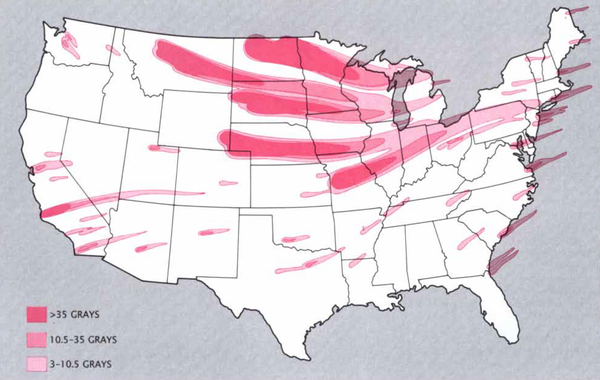The ratification of the agreement between the U.S. and the Soviet Union to ban all intermediate-range nuclear missiles and the apparent progress in the so-called Strategic Arms Reduction Talks (START), which have as their primary aim a 50 percent cut in the number of long-range ballistic-missile warheads, have given many observers reason to be optimistic about the prospect for further reductions in nuclear arms. Further reductions, however, will require the U.S. and the Soviet Union to reassess many of the military missions they have planned for their nuclear forces in the event of war.
The missions that would be most affected by further nuclear-arms reductions are generally known as counterforce missions. Their purpose is to destroy the military capabilities of the opponent, including nuclear and nonnuclear forces as well as the industrial base on which the forces depend. Since an opponent’s strategic forces represent the greatest threat, they are considered to be the highest-priority targets for counterforce missions. Because there are thousands of potential targets for a strategic counterforce mission, it requires a nuclear arsenal of vast size.
Many defense analysts argue that threatening to destroy a variety of military targets deters limited aggression more effectively than threatening to attack cities, because such threats are less likely to elicit a devastating counterstrike against the cities of the attacker and can therefore be made more credibly. In addition, the country that first executes such missions might hope to destroy many more of the other side’s warheads than it employs in carrying out the attack. Such a lopsided exchange is made possible by modern nuclear missiles that carry multiple warheads, each of which is capable of destroying a different target. Unfortunately, the perception that one might gain by striking first leads to crisis instability: each side is tempted to preempt the other side’s attack if nuclear war appears inevitable.
On supporting science journalism
If you're enjoying this article, consider supporting our award-winning journalism by subscribing. By purchasing a subscription you are helping to ensure the future of impactful stories about the discoveries and ideas shaping our world today.
That dangerous situation can be prevented if nuclear forces are structured in such a way that neither side would gain an advantage by striking first. A START agreement as outlined in the current negotiations would not achieve this, since it would allow each side to retain its most modern multiple-warhead missiles. Crisis stability can be achieved by ensuring that reduced nuclear forces incorporate single-warhead intercontinental ballistic missiles (ICBM’s) and survivable basing modes for all weapon launchers. Such a nuclear-force structure, however, is incompatible with the strategic counterforce mission.
But does the U.S. or the U.S.S.R. need to rely on a strategic counterforce mission to prevent nuclear aggression? Does it really provide a more credible deterrent by threatening military targets and not civilian ones? Our calculations suggest the answer is no: they show that a large-scale attack on strategic forces would cause so many civilian casualties that it would be difficult to distinguish from a deliberate attack on the population.
Curiously enough, the number of civilian deaths that counterforce attacks would cause remains largely a neglected topic in the nuclear-weapons policy debate. Even during the 1980 presidential campaign, when the vulnerability of U.S. ICBM’s became a political issue, the civilian casualties that would result from an attack on the ICBM’s was not even mentioned. Indeed, we know of only one public discussion of the subject by the U.S. Department of Defense—and that took place in 1975 [see “Limited Nuclear War,” by Sidney D. Drell and Frank von Hippel; Scientific American, November, 1976]. We reexamine the subject here in order to present estimates of the civilian casualties from a U.S. attack on Soviet strategic forces as well as the reverse. In doing so we gauge the impact of changing some of the assumptions made by the Defense Department in estimating U.S. casualties.
In our calculations we considered the consequences of attacking with nuclear weapons 1,215 military facilities in the U.S. and 1,740 military facilities in the U.S.S.R. All but approximately 100 of the targets on each side are either missile silos or their associated launch-control centers. The disparity between the numbers of targets is due to the fact that the Soviet Union has more missile silos than the U.S. Other targets on the lists are bases for long-range bombers, ballistic-missile submarines, aircraft carriers and ships carrying long-range, nuclear-armed cruise missiles. Furthermore, we assumed that early-warning radar installations and key command-and-communication facilities would also be struck by nuclear weapons in order to effect the maximum surprise and blunt the effectiveness of any retaliatory attack. (It should perhaps be pointed out that some defense planners argue against attacking command-and-communication facilities, since it could preclude a negotiated end to the conflict.)
The list of targets in the U.S. includes major nuclear-weapon depots and bases for the tanker aircraft that would refuel U.S. bombers on the way to and from their targets in the Soviet Union. The list of targets in the U.S.S.R. includes anti-ballistic-missile launchers around Moscow and bases for mobile intermediate-range missiles and nuclear-armed bombers, which could be employed to attack facilities of the North Atlantic Treaty Organization in Europe.
A review of the listed targets indicates that many of them lie in or near major urban areas. (Their approximate locations are known from the enormous amount of information that is made public by the U.S. Defense Department.) In the U.S., for example, tanker aircraft are based at airports near Chicago, Milwaukee, Phoenix and Salt Lake City; Navy bases for nuclear-armed vessels are situated in San Francisco Bay and at Long Beach near Los Angeles (and one is planned for Staten Island in New York Harbor); key command posts are in the vicinity of Washington, D.C., and Navy radio transmitters are located in or near Jacksonville, Sacramento and San Diego. In the U.S.S.R. there is a similar colocation of strategic-weapon facilities and urban areas: Moscow is ringed with underground command bunkers; Leningrad is the headquarters of the Baltic fleet; Vladivostok is a home port for ballistic-missile submarines, and many ICBM fields are found in the densely populated western region of the country.
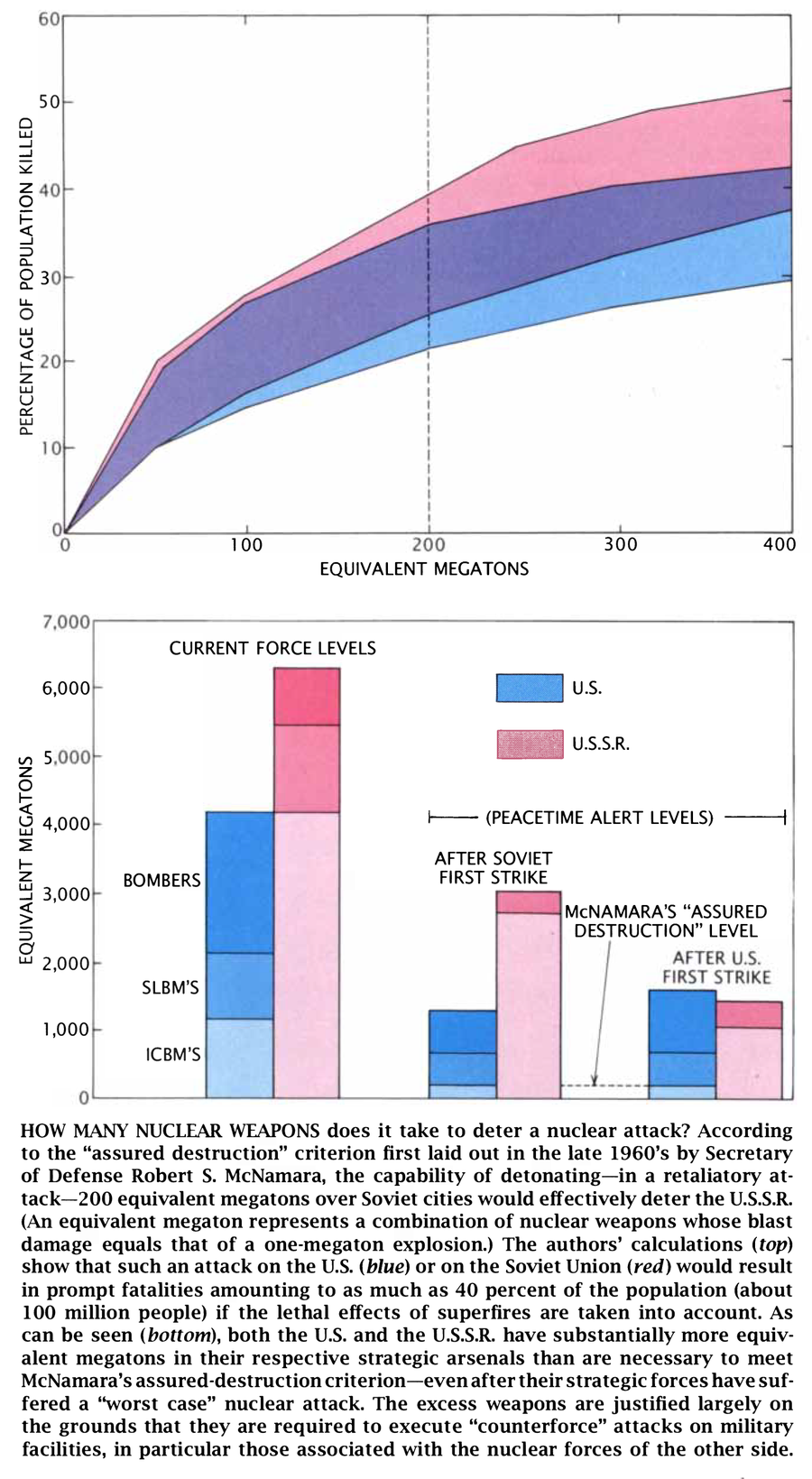
Credit: Thomas C. Moore
We assigned nuclear weapons to each target and specified their mode of employment according to target type. If the target was an ICBM silo or its associated launch-control center, the most accurate ballistic-missile warheads were assigned to it, because such “hard” targets can be destroyed only by powerful nuclear weapons detonated no more than a few hundred meters away. The fireballs of such explosions would inevitably come in contact with the ground, and as a result they would produce large amounts of radioactive fallout. In keeping with standard military planning, such facilities were targeted with two nuclear warheads to ensure against the failure of one of them.
If the target in question was an airbase, we assumed it would be attacked not only with one large warhead detonated at or near ground level but also with some 15 warheads detonated in the air, which could be delivered by two multiple-warhead submarinelaunched ballistic missiles (SLBM’s). The reason is that a significant fraction of U.S. long-range bombers and their associated tanker aircraft are kept on alert, ready to take off on warning of an attack. A groundburst and several airbursts would be intended to destroy the aircraft still on the ground and those already airborne but not yet out of the area. We have assumed in our calculations that Soviet mobile-missile bases would be attacked in a similar way.
Overall, the hypothetical Soviet strategic counterforce attack on the U.S. involved about 3,000 warheads with a total yield of about 1,300 megatons, whereas the U.S. attack on the Soviet Union involved slightly more than 4,000 warheads with a total yield of about 800 megatons. (A megaton is defined as the energy released by the detonation of a million tons of TNT.) Such attacks are well within the capabilities of each nation, even after the reductions envisioned in the START negotiations. The greater number of warheads and lower total megatonnage of the U.S. attack on the Soviet Union result from respectively the greater number of Soviet missile silos and the smaller average yield of U.S. strategic warheads.
In calculating the number of civilians who might die or sustain injury as a result of a large-scale strategic counterforce attack, we considered only the direct effects of nuclear explosions: blast, fire and radioactive fallout. The standard method applied by the U.S. Defense Department and the Federal Emergency Management Agency (FEMA) for estimating the casualties arising from the first two nuclear-weapon effects relies on extrapolating the consequences of the relatively small-yield (.015 megaton) explosion over Hiroshima to the much more powerful nuclear explosives in modern strategic arsenals. To be specific, the model applied in the Government’s extrapolation, which we call the overpressure model, assumes that the casualty rate would be the same as the rate observed in Hiroshima for a given value of the peak blast overpressure: the maximum air pressure (above the ambient level) produced by the explosion’s blast.
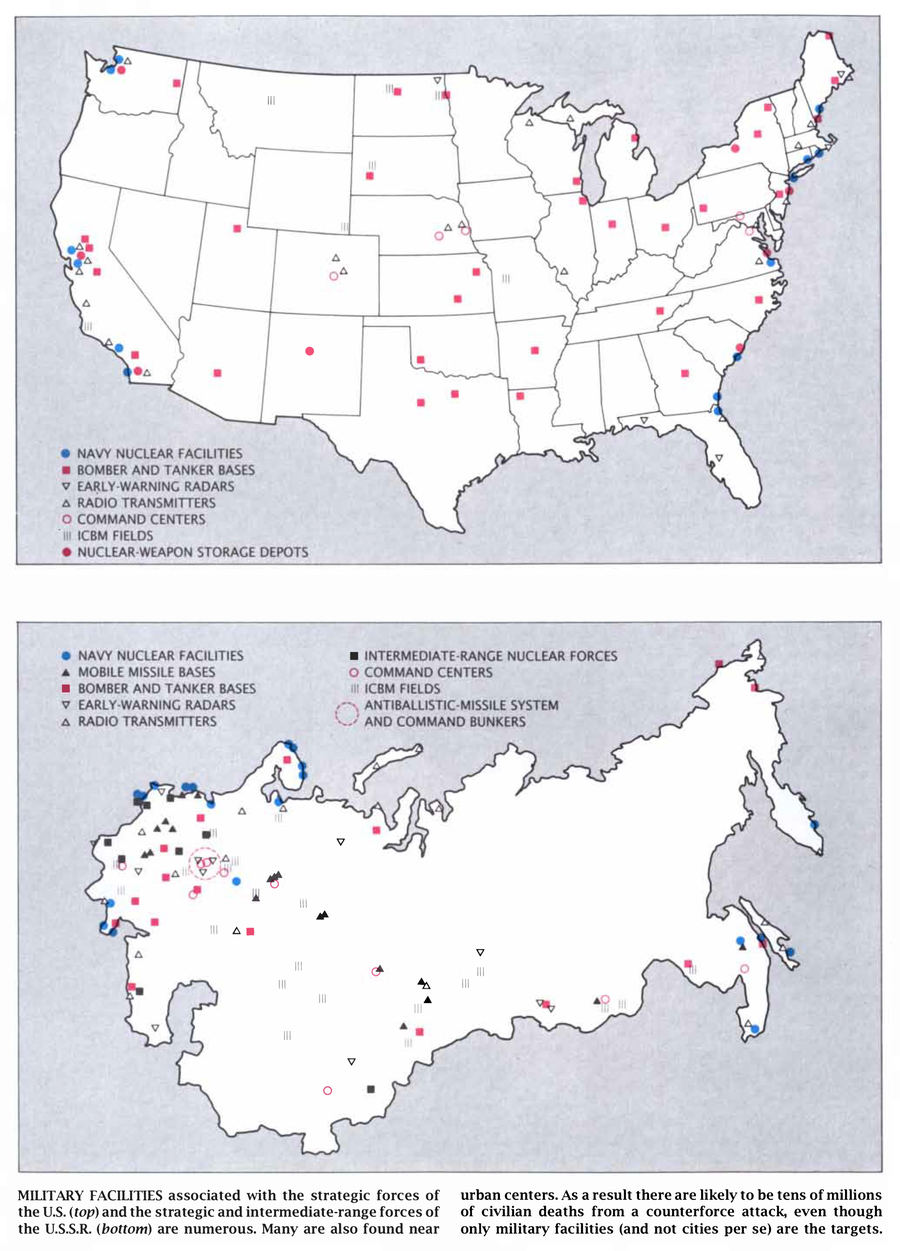
Credit: Thomas C. Moore
Yet some of the casualties at Hiroshima were a consequence of a huge fire that developed approximately 20 minutes after the explosion and covered a roughly circular area having a radius of about two kilometers. The area was small enough so that most of the people who had not been trapped under collapsed buildings or otherwise incapacitated were able to escape before the environment in the fire area became lethal. Recent studies done for the Defense Nuclear Agency by Harold L. Brode and Richard D. Small of the Pacific-Sierra Research Corporation suggest that detonation of nuclear warheads over U.S. and Soviet cities and suburbs could result in much larger superfires: huge conflagrations fanned by hurricane-force winds. Given the typical yield of today’s strategic nuclear weapons (at least 10 times greater than the Hiroshima weapon), the conflagration area would be so large that people would not be able to escape before they succumbed to the combined effects of heat, smoke and toxic gases. On these grounds one of us (Postol) suggested in 1985 that the Defense Department and FEMA might be seriously underestimating the potential fatalities from the direct effects of nuclear explosions.
The conditions that would prevail in a superfire caused by a nuclear explosion resemble the conditions during the fire storm that developed in Hamburg after an intense Allied incendiary attack in July, 1943. In that case basement shelters provided little protection from the lethal effects of carbon monoxide and the extreme temperatures generated by the overlying smoldering debris. In spite of the fact that Hamburg was not subjected to blast or radiation effects during the attack, the area destroyed was about 12 square kilometers (about the same as the area of conflagration at Hiroshima) and the death toll was estimated at between 50,000 and 60,000 (also comparable to that at Hiroshima).
Although any prediction about the extent of urban fires caused by nuclear explosions is uncertain, we believe the probability of lethal superfires is great enough so that casualty estimates should take them into account. We have done so by making casualty estimates with both the traditional overpressure model and our own superfire model. The respective results define the lower and upper end of a range of uncertainty.
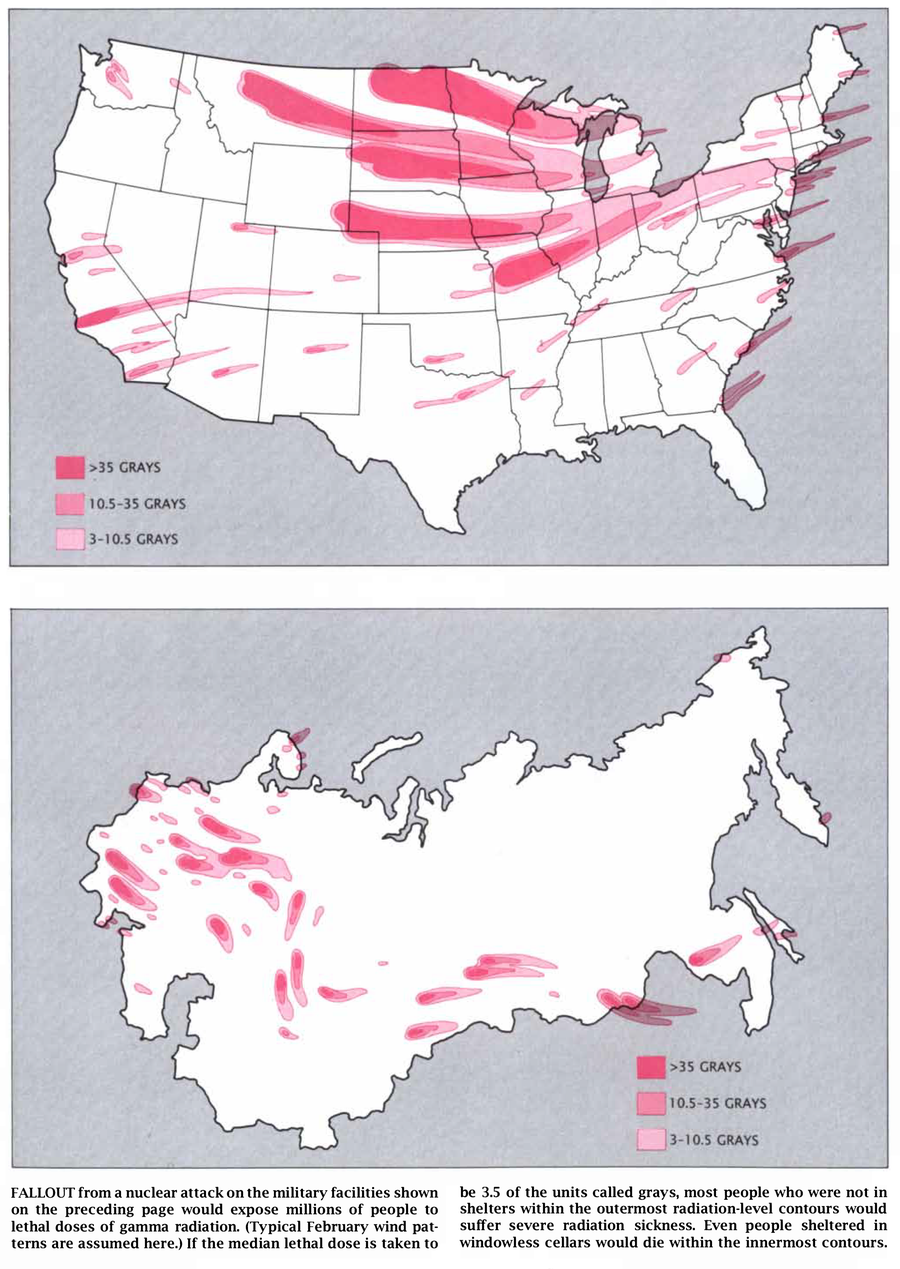
Credit: Thomas C. Moore
The other cause of death associated with nuclear explosions is fallout: soil and debris sucked up into the fireball of a low-altitude nuclear explosion that eventually falls back to the ground heavily contaminated by fission products. The fallout that settles downwind of a nuclear explosion can create a zone of gamma radiation so intense that people without adequate shielding in the zone would die of severe radiation sickness. In estimating the casualties caused by radioactive fallout, we adapted a Government computer model designed to predict the way fallout would be dispersed and drew on Government databases for wind patterns and population distributions.
We also considered the possibility that the resistance of human beings to ionizing radiation under wartime conditions might be much less than has been traditionally assumed. This possibility was suggested by a recent reanalysis of the data on the casualties at Hiroshima.
Since World War II the standard assumption made in Government analyses has been that an exposure to 4.5 grays of gamma radiation within a period of less than two weeks constitutes the so-called LD-50 dose: the dose that causes lethal radiation sickness in 50 percent of an exposed population within about 60 days. (A gray is the metric unit for measuring doses of ionizing radiation. A rad, which may be more familiar in the U.S., is one-hundredth of a gray.) That assumption was based primarily on experimental data from animals, but it seemed to be consistent with the human data from Hiroshima.
A few years ago, however, investigators at the Lawrence Livermore National Laboratory discovered that the estimated radiation exposures for those unfortunate enough to be in Hiroshima at the time the atom bomb was dropped were too high. This led a group of Japanese investigators to reexamine the fates of more than 3,000 Hiroshima inhabitants who had not suffered severe blast or burn injuries from the bomb’s explosion but were near enough to ground zero to be exposed to direct gamma radiation. When the new Lawrence Livermore results were applied to determine the radiation doses for each individual in the Hiroshima group, a surprisingly low estimate for the LD-50 was obtained: just 2.5 grays.
The Hiroshima victims, of course, did not benefit from the modern treatment for radiation sickness, which involves placing the victim in a sterile environment and administering heavy doses of antibiotics. Yet modern medicines and hospital care would probably be as unavailable to the survivors of a large-scale nuclear attack today as it was to the survivors of Hiroshima. We therefore varied the values of the LD-50 in our calculations from 2.5 to 4.5 grays.
The number of casualties estimated for the attacks also depends on the strength and direction of the winds at the time of the attack, because it is the wind that disperses radioactive fallout. Of the four seasonal wind patterns we considered, we found that the strong winds typical of February produced the highest number of deaths in both the U.S. and the U.S.S.R. The doses from fallout radiation could be reduced to a certain extent by taking refuge in shelters.
Every shelter can be assigned a protection factor: the number by which the open-air fallout-radiation exposures would have to be divided in order to give the actual radiation dose in the shelter. We assumed that the population of both the U.S. and the U.S.S. R. would be equally divided between a group that did not spend much time in underground shelters (and therefore had an average effective protection factor of about three) and a group that did spend most of its time in shelters (and therefore had an average effective protection factor of about 10).
Fallout shelters with higher protection factors do exist, but it would be difficult for people in them to reduce their average radiation dose to levels substantially lower than what we assumed. The reason is that most of the sheltered population would have to emerge within a few days to replenish supplies or seek help, and even a short period spent outside the shelters would greatly increase the radiation dose. Average radiation doses would be increased anyway within a relatively short time as people began to consume water and food contaminated by radioactivity.
Our calculations indicate that the direct effects of the blast, fire and radioactive fallout of a Soviet attack on U.S. strategic nuclear facilities could kill between 12 and 27 million people. The corresponding U.S. attack on Soviet strategic nuclear facilities could kill a comparable number: between 15 and 32 million people. (We also estimate that the survivors of the attacks would suffer between one and eight million additional deaths from cancer over their remaining lifetimes as a result of their exposure to fallout radiation.)
The numbers at the low end of our ranges, which were derived by applying the overpressure model and assuming an LD-50 of 4.5 grays, are consistent with the estimates presented by the Defense Department in 1975. The numbers at the upper end of our ranges were obtained from the superfire model and an LD-50 of 2.5 grays.
In our results the deaths from blast and fire are roughly comparable in number to those from fallout. Although the percentage of the area of the U.S. subjected to lethal levels of fallout radiation was found to be larger than that for the U.S.S.R., there would nonetheless be comparable numbers of casualties from the radiation in both countries, since much of the fallout over the Soviet Union would descend on the heavily populated European region of the country.
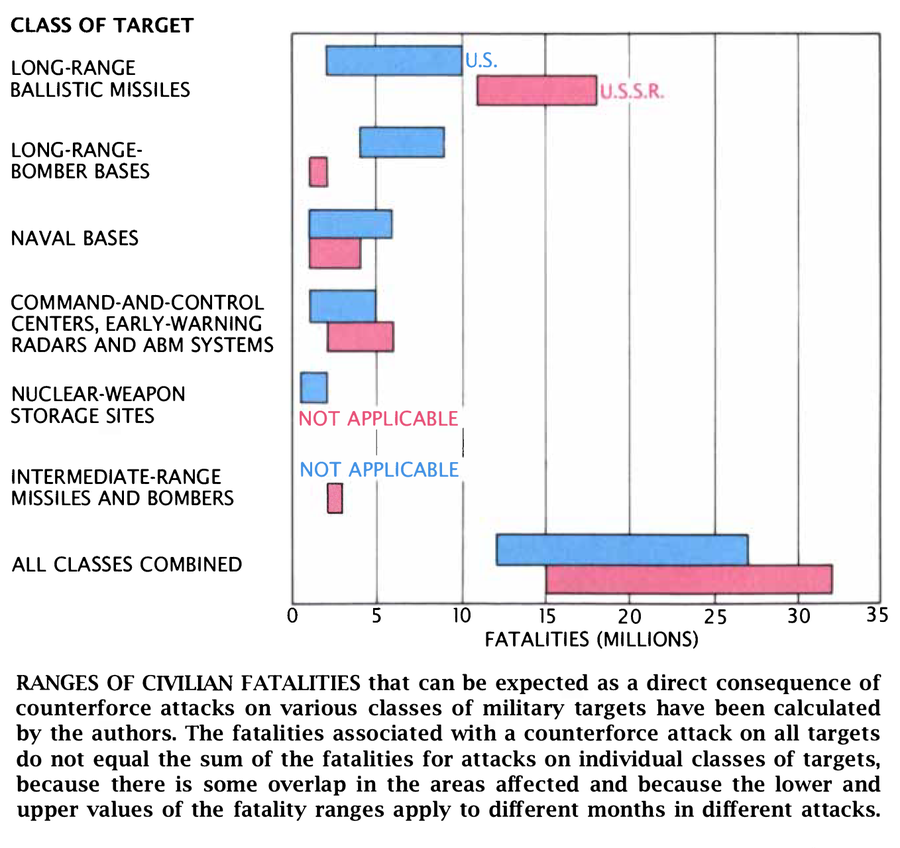
Credit: Thomas C. Moore
Limiting the attack to any subset of counterforce targets, such as missile silos, bomber bases, naval bases, weapon storage depots, command-and-communication facilities or intermediate-range forces (in the case of the U.S.S.R.) would cause at least a million deaths in all cases but one [see illustration below]. Hence one could not hope to reduce the casualties below many millions by eliminating one or two classes of targets. Our casualty estimates for the U.S.S.R., for example, would be only about 10 percent lower if we had not included as targets the intermediate-range missiles, which are to be eliminated over the next few years. (Actually the effect of the elimination of the Soviet intermediate-range missile will be approximately offset by the replacement of Trident warheads with more powerful Trident II warheads on U.S. ballistic-missile submarines.) On the other hand, our casualty estimates for both sides would have been considerably higher if we had included other classes of plausible military-related targets.
For example, we estimated separately the civilian casualties that would result from an attack with one-megaton airburst warheads on a group of 101 factories identified as being among the highest-priority targets in an attack on U.S. military-industrial capability. These factories manufacture such items as missile-guidance systems, automatic guns for aircraft, antitank missiles, radars and command-and-control systems. We found that the attack would kill between 11 and 29 million people. The toll is that high because most of the military-industrial targets are in major urban areas, such as those surrounding Boston, Detroit and Los Angeles.
Finally, it should also be kept in mind that we have considered only the casualties that would be caused by the direct effects of nuclear explosions. Tens of millions of additional deaths might result from exposure, famine and disease if—as seems likely—the U.S. or the Soviet Union suffered economic and social collapse after a nuclear attack. The populations of other nations around the world would also suffer indirectly from the manifold economic and environmental effects of such an attack.
Our results reaffirm an assertion made more than 25 years ago by the chairman of the Joint Chiefs of Staff, Gen. Lyman L. Lemnitzer, when he briefed President John F. Kennedy on the U.S. nuclear war plans: “There is considerable question that the Soviets would be able to distinguish between a total attack and an attack on military targets only.... Because of fallout from attack of military targets and colocation of many military targets with [cities], the casualties would be many million in number. Thus, limiting attack to military targets has little practical meaning as a humanitarian measure.”
Yet for the past two decades the U.S. and the U.S.S.R. have continued to develop increasingly elaborate counterforce targeting strategies, ignoring the fact that the large-scale application of nuclear weapons against military targets is not qualitatively different from their application against civilians. In view of the massive civilian casualties counterforce attacks would entail, threatening to execute such attacks can be no more credible than threatening to destroy cities.
It is clear that eliminating counterforce weaponry by treaty would be preferable to eliminating them by use on one another. Yet it is the very reliance on counterforce strategies that blocks stabilizing nuclear-force reductions beyond those currently being considered in the START negotiations.
